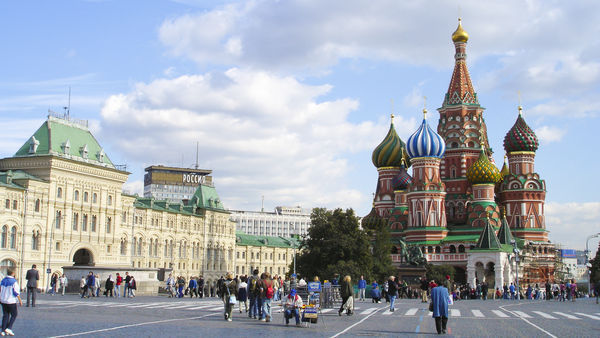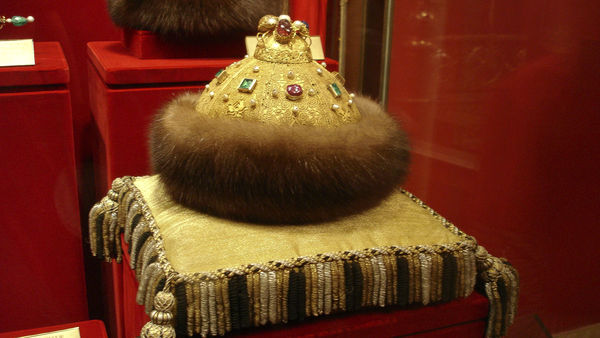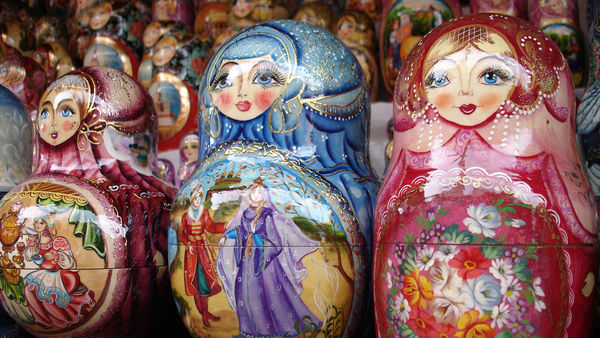Moscow Impressions



By Cameron Hewitt
As my cab pulled away from the Moscow airport, I admired the sunshine. "The president wanted nice weather for our City Day celebration," the taxi driver explained. "So he sent the air force to seed the clouds and make it sunny. It usually lasts for a few days, then we have terrible weather."
Control versus chaos — that formula came to define my Russian experience. My journey to Russia turned up all of the stereotypes — onion domes, stacking dolls, hammers and sickles, exasperating bureaucracy — but it also went well beyond the clichés. Russia is a byzantine, mystifying, and exhilarating place that lives according to its own rules. Self-important soldiers wearing pointy hats keep watch over a swirling sea of hard-partying twentysomethings with scant memories of communism, stylishly dressed new-rich millionaires, and impoverished babushka grandmothers desperately begging for spare change.
After St. Petersburg, Russia's other obvious sightseeing "must" is Moscow, its blockbuster capital. Moscow was a rough-and-tumble village on the fringe of Western Civilization that blossomed into one of the most powerful cities on earth. If you go as a mindless tourist, you'll be beguiled and frustrated. But if you go as an anthropologist and a student of Russian life, you'll love it.
As the former capital of an "evil empire," Moscow holds a certain mystique for Western visitors as an enigmatic, difficult, even dangerous place. And maybe it is all those things. But it's also enthralling, and squeezed between the dreary apartment blocks are pockets of intense beauty: people-filled parks, breathtaking urban vistas, and some of the best museums in Europe. Moscow is enormous. With ten and a half million residents, it's the most populous city in Europe. And everything has been built on a huge scale. Bigger is better. Secondary streets are 10 lanes wide. Tunnels between Metro platforms have 40-foot-high ceilings. And what looks like "just two blocks" on the map takes about 20 minutes to cover on foot.
To cope with the sprawl, the city has the world's busiest people mover. The Moscow Metro carries more passengers per day than the London and Paris subways combined. It's extensive, speedy, and remarkably efficient. Stand still in a Metro station at rush hour and observe: People pour into the entrances at a rate of hundreds per minute, waiting patiently for their turn on the long, steep escalators that plunge them deep into the guts of the city. About once a minute, a train pulls up to the platform, hundreds of people get off, hundreds more people get on, and the train pulls out. A minute later, the next train rolls in... and the whole procedure is repeated.
For Muscovites, the Metro shrinks a gigantic metropolis. But for the uninitiated, it's an intricate puzzle. Of course, signs are only in the Cyrillic alphabet. Even more confusing, the name of the station isn't prominently posted within view of the arriving train. You just have to "know" your stop. For a tourist, this means keeping your eyes glued to a Metro map and counting stops, while straining to hear announcements on the crackling loudspeaker. (That is, if you can figure out how your stop is pronounced.) At least riding the Metro has some redeeming sightseeing value. Many of the stations are designed as ornate underground palaces, with delicate decorations and grand halls that seem out of place above grimy railroad tracks. And it's an incredible bargain in this expensive city.
Another riddle is finding reliable tourist information. Ponder this: Even though Moscow is the biggest city in Europe, it doesn't have a tourist office. This means there's no place where perplexed tourists can find smiling, English-speaking locals to lead them through the city's snarls, and no racks of glossy brochures suggesting ideas for how to spend your time. You're on your own. The result: lots of wasted time. Travelers accustomed to sightseeing efficiently find Moscow maddening. You arrive at the theater to discover today's concert started an hour ago. You walk 45 minutes to reach the dock for the river cruise, then realize you're at the wrong dock. I began each day with an ambitious itinerary of five or six sightseeing goals. In most cities, I'd expect to get to virtually all of them. In Moscow, by late afternoon I'd find myself just barely getting to item #2. Finally I hit on a successful formula: Choose one thing you want to do each day. Do your best to accomplish it, and expect that it'll take the entire day. Then, if you have some time to spare, consider it a bonus.
But despite its aggravations, Moscow is a glorious city. And there's no better place to begin than on Red Square. Moscow's cobbled main square is grandiose and monumental, lined with strikingly ornamented buildings and crowned by the otherworldly onion domes of St. Basil's Cathedral. One side of Red Square is defined by G.U.M., a massive, yet genteel, Soviet-era shopping gallery topped by a cheery glass canopy. Across the square is one wall of the immense Kremlin complex — each guard tower still topped by a proud peachy-red star. And butting up against the bottom of the square is the hulking Rossiya Hotel — a brooding communist-era eyesore that has a date with the wrecking ball.
Crouching by the Kremlin wall on Red Square is Lenin's Mausoleum, housing the long-preserved cadaver of the father of the Soviet system. Somber visitors — ranging from deflated communists to curious tourists — shuffle silently down the stairs to see the famous corpse, all lit up in a glass case and wearing a tastefully subtle polka-dot tie. (Some visitors whisper that the real Lenin was supposedly replaced with a wax copy some years back.) Behind the mausoleum are the graves of various Soviet heads of state, including Josef Stalin's…decorated with fresh flowers. Old habits die hard.
The Kremlin — a walled City of Oz containing the historical, governmental, and religious nucleus of Russian civilization — enjoys a commanding position on the Moskva River bank next to Red Square. The back side of the fortress consists of a broad, grassy park called Alexander's Garden, populated by sauntering locals and giddy tourists licking ice-cream cones. Here newlyweds place flowers at the Tomb of the Unknown Soldier, while observant visitors notice that since the tomb's guard is required to stand forever at attention, periodically another guard goose-steps out to wipe his nose.
The interior of the Kremlin is mostly off-limits to outsiders, but two areas welcome tourists. The Kremlin's centerpiece, Cathedral Square, is a cluster of spectacular gold-domed cathedrals. On this "St. Peter's Square" of the Russian Orthodox Church, tourists pose for group photos as the domes glimmer in the sunshine — seeming to celebrate the survival of a religion that stared down extinction under the previous, atheistic regime. Stepping into one of the cathedrals, you're immersed in a sumptuous world of gilded icons, mystically fragrant incense, and — if you're lucky — chanting monks.
Nearby, also in the Kremlin, is one of Europe's best treasury collections (inexplicably dubbed "the Armory"). This museum offers an opportunity to stroll through the amassed riches of Russian royalty — priceless Fabergé eggs, elaborate horse carriages, gaudy gowns belonging to famous czarinas, and the distinctive Crown of Monomakh. Like Russia itself, this royal headgear incorporates elements both European (a golden crown) and Asian (a fringe of animal hide, like a classic Russian fur hat).
The Kremlin Museums are surprisingly uncrowded and offer well-produced English audioguides. But even this slickest tourist sight in Moscow comes with bewildering bureaucracy. After visiting three different ticket windows, I was finally able to buy a ticket and hike 10 minutes to the Armory entrance — only to be sent back to the ticket window to check my bag. When I asked the ticket seller where I could do this, she shrugged. I finally discovered the bag check…just 20 feet away from the oblivious ticket seller.
Art-lovers find plenty to keep them busy in Moscow. The city's two top galleries have very different personalities. The Pushkin Museum of the Arts features Western European masters — impressive, but a bit out of place deep in the heart of Russia. More fitting is the Tretyakov Gallery, arguably the world's best collection of Russian art. Even if you enter as a Russian-art novice, you'll leave with a new appreciation for painters virtually unknown outside their homeland. I came away with a new list of favorites. Pavel Fedotov's satiric, almost cartoon-like genre paintings — wittily skewing the foibles of the late-19th-century upper class — captured my imagination. And Vasily Vereshchagin's vivid images of Central Asia made me want to plan another trip…to Turkey.
On the whole, Russia is surprisingly expensive. Most tourist attractions have two-tiered pricing: Russians pay one entry fee, while foreigners pay a different, much inflated fee. Even though the Russian economy is struggling, food prices are on par with Western Europe and the US.
Boat cruises on the Moskva River help visitors get their bearings. The cruises meander slowly past key landmarks, including the 16-story-high monument to Peter the Great, looking a bit lost so far from his namesake capital; the colossal golden-domed Church of Christ the Savior, which was demolished under Stalin, then rebuilt after the fall of communism; the stately Kremlin, reminding visitors of the city's humble beginnings and illustrious history; and the Riverside Towers, a super-modern business district that seems to herald the dawn of a new economic era. Along the way, the boat passes some of the "Seven Sisters." These towering skyscrapers — hotels, civic buildings, and apartment complexes built by Stalin in his favorite neo-Gothic style — brood over the city like sleeping vampire bats.
Farther afield is one of Europe's biggest outdoor markets: Izmailovskii Market. Most of this sprawling swap meet is decidedly Russian, with people from every corner of the former Soviet empire selling knock-off shoes, bags, clothes, and electronics. But one section is dedicated to tourists: a souvenir market offering a wide variety of Russian kitsch. The old standard-issue Red Army gear and busts of Lenin are popular, as are the painted-and-lacquered kitchenware and the fur hats. But you can't leave Russia without picking up a set of nesting Matryoshka dolls. The classic version depicts smiling babushki or Russian fairy tales. But the options don't end there. Whether you're looking for Russian heads of state, infamous terrorists, US politicians, Beatles, rappers, cartoon characters, or any sports team ever to take the field, you'll find it here. Browsing for the Ohio State University football team, I wondered aloud whether this year's squad was the one I wanted. "Which year do you want?" the salesman asked. I requested 2002. He disappeared behind the kiosk...and came back holding a set of dolls with all the key players from that championship team. After some serious haggling, I paid only $15 for the entire set.
For a time machine back to the Soviet era, take the Metro to the All-Russia Exhibition Center (abbreviated VVTs in Russian). Built during the glory days of the Soviet Union, it was originally called the "Exhibition of Achievements of the National Economy of the USSR" (or VDHKh). Imagine an Epcot Center designed to showcase Soviet ideals: a vast park peppered with pavilions dedicated to such socialistic ideals as Agriculture, Nuclear Engineering, Animal Husbandry, and the diverse cultures of the Soviet Republics (such as Armenia and Georgia). Today, even though these pavilions have long since been converted into cut-rate shopping malls, all that original communist symbolism is still intact. A giant Vladimir Lenin surveys the skateboarders and shoppers, surrounded by flower planters in the shape of red stars.
Yes, while the communists have fallen, their emblems remain. In former Soviet satellites like Warsaw, Budapest, and Prague, these symbols were a sign of hated foreign oppression, torn down along with the Berlin Wall. But here in Russia, the red stars and hammers-and-sickles are indigenous. They're just one chapter — arguably the most successful one — in a long and illustrious history.
Cameron Hewitt is the co-author of the Rick Steves Scandinavian & Northern European Cruise Ports guidebook.

